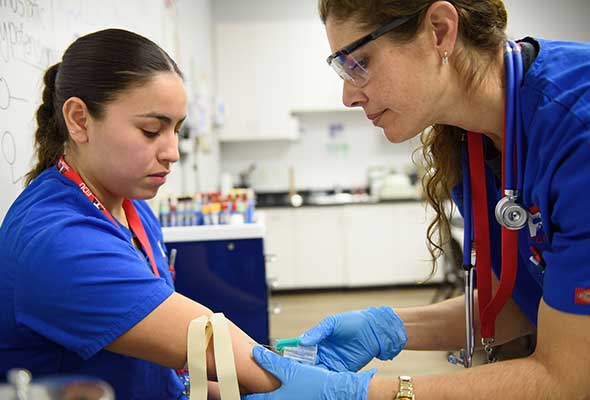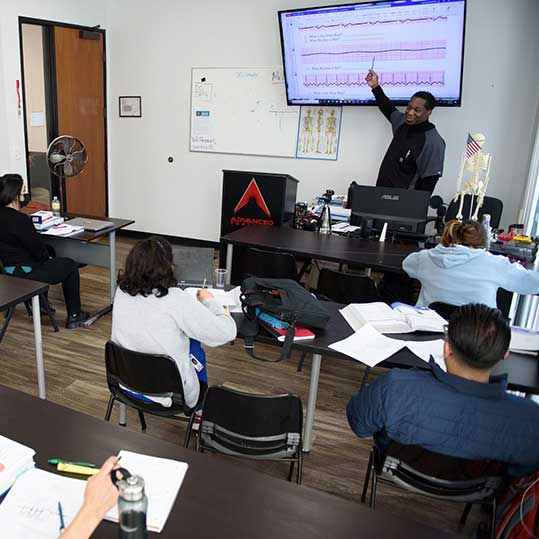- Career College serving San Diego County
Are you looking for a Medical Assistant Program in El Cajon, San Diego? ATA College offers a medical assistant diploma program that can be completed in just 8 months.
Learn the skills to become a medical assistant in just 8 months at ATA College in El Cajon! Our Medical Assistant program is designed to help you start a rewarding healthcare career. Visit our website now for more details!
Hands-on training by industry experts.
Morning and Evening Classes are Available Now!
Train For a Career in Medical Assistant In 8 Months
Job Placement Assistance, Resume Development, Cover Letters, Career Workshops
ATA College’s Medical Assistant program in El Cajon, San Diego, is designed to equip you with the skills and knowledge you need to launch your medical career. Our program includes on-the-job training, hands-on learning, and classroom instruction, allowing you to gain valuable experience in a real-world setting.
Our experienced instructors provide the guidance and support you need to succeed in your medical career. Our instructors are committed to providing you with the most up-to-date information and techniques, ensuring you are fully prepared for a successful career in the medical field.

Pursue your dreams at ATA College and get your Medical Assistant diploma in 8 months. Our accredited Medical Assistant program is designed to help you start a rewarding career.
33 Semester Credits / 34 Weeks
Financial Aid Available For Those Who Qualify.
ATA College is approved by the California State Approving Agency to enroll veterans and other eligible persons who qualify for VA Benefits.
ATA College proudly presents an accelerated 8-month diploma program for medical assistants in El Cajon, San Diego, California.
After completing the diploma program at ATA College, students can continue in the medical assistant, associate of applied science program.
64 semester credits / 60 weeks
Financial Aid Available For Those Who Qualify.
The associate degree program can be completed in an additional 6 months.
Ambulatory Surgery Centers, Doctor's Offices, Mental Health Clinic, Medical clinics.
Looking to start a rewarding career in medical assisting? ATA College in El Cajon, San Diego, is the perfect place to begin your journey. Our program provides training to equip you with the necessary skills for a career in this exciting field.
The medical assistant program is a education and training course designed for those seeking a career in the healthcare industry. This program covers various topics, including anatomy and physiology, medical terminology, clinical procedures, and pharmacology. It also includes hands-on training in areas such as taking vital signs, administering injections, and performing electrocardiograms.
After completing the diploma program at this El Cajon, San Diego medical assistant school, ATA college students can continue in the medical assistant, associate of applied science program. The associate degree program can be completed in an additional 6 months and contains general education courses, and courses to prepare you for medical assistant and EKG national certification through the NCCT.
As the healthcare industry continues to expand rapidly, the job outlook for medical assistants is quite promising. Medical assistants are vital in healthcare facilities and work closely with patients, doctors, and other healthcare professionals. The Bureau of Labor Statistics predicts a 23% growth in employment for medical assistants from 2018 to 2028, much faster than the average for all occupations.
With an aging population requiring more healthcare services, medical assistants are in demand. In addition to being an informative career choice, becoming a medical assistant can open up other opportunities within the medical field. Overall, the job outlook for medical assistants is bright, making it a wise career choice for individuals looking to enter the healthcare industry.
Graduates of the program are prepared to work in various healthcare settings, including hospitals, clinics, and physician’s offices. The program provides a solid foundation for those seeking a fulfilling career helping others in medicine. It is an informative and valuable resource for those looking to take the next step in their healthcare career.
Looking to start a new career? ATA College is here to support you every step of the way. Discover our exciting career options and take the first step to unlock your potential today. Get in touch with us now for more information!

Discover the advantages of our programs, the exciting coursework you’ll undertake, and everything needed to apply!